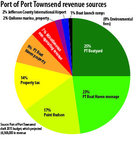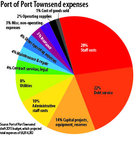The marine trades in Jefferson County directly employs an estimated 400 people; that's more than Port Townsend Paper Corp. (the largest single private employer) and more than Jefferson Healthcare …
This item is available in full to subscribers.
We have recently launched a new and improved website. To continue reading, you will need to either log into your subscriber account, or purchase a new subscription.
If you had an active account on our previous website, then you have an account here. Simply reset your password to regain access to your account.
If you did not have an account on our previous website, but are a current print subscriber, click here to set up your website account.
Otherwise, click here to view your options for subscribing.
* Having trouble? Call our circulation department at 360-385-2900, or email our support.
Please log in to continue |
|



The marine trades in Jefferson County directly employs an estimated 400 people; that's more than Port Townsend Paper Corp. (the largest single private employer) and more than Jefferson Healthcare (the largest single public employer).
Most of the marine trades revolve around the Port of Port Townsend, either at the Boat Haven property, with its moorage, storage, boatyard and buildings, or at Point Hudson.
Exactly what, and who, supports the marine trades infrastructure has predictably been raised during the ongoing election campaign for the District 1 seat on the three-member Port of Port Townsend commission. Diana Talley, a marine trades business owner, is challenging Steve Tucker.
Is there a so-called "cash cow" within the port's defined revenue centers (moorage, Boat Haven, boatyard, Quilcene, boat ramps, Point Hudson, Jefferson County International Airport)? And how much do property-owning taxpayers, who may never directly use a port service, contribute?
'NO CASH COWS'
Abigail Berg joined the port as finance director in June 2015, so this is her first budget cycle. Last month, at request of the commissioners, she prepared a non-traditional financial summary of port operations to address the age-old debate on the port's profit centers in terms of direct operating revenue and expenses. (See table on page A 5.)
"The whole exercise is to show the commission and management that there are no cash cows," Berg said.
In her view, and in how the port's budget is already being managed with revenue from operations, fees, land leases, building leases, grant money and property taxes, it's all in one pot.
"At the end of the day, the port is one entity," Berg said. "It is not like a utility which has a separation between water and electricity. The port is one entity and [all revenue] goes to support one entity."
Tucker, first-term District 1 incumbent, advocated for the financial exercise because he, too, has heard about so-called "cash cows" from which money is pulled to support other parts of the operation.
"The port has no 'cash cows,'" Tucker wrote to the Leader. "Even though the marina, boat yard and Point Hudson generate substantial revenue, their upkeep is more substantial."
Talley, during her campaign, has talked about her "on the ground" experience at the port as worker, manager and business owner. She noted that the port's mandate is to promote economic development.
"It is vital we keep [the marine trades industry] strong to keep the revenue stream coming in," Talley said, adding later that, "I believe the marine trades industry is paying for itself."
Moorage and yard rates here are lower than some operations in Puget Sound, and more than some, port officials have said. Moorage rates, for example, are higher than Port Angeles, and lower than Sequim.
Bertram Levy, an advocate of the Port Townsend Moorage Tenants Union and often a critic of port leadership, said that moorage is a "cash cow" that can "no longer subsidize other port projects because the moorage revenue is needed now to pay the debt service on its own replacement. No taxpayer money is used to support the Boat Haven debt service," Levy wrote to the Leader.
FUNDING POWER
At a candidate forum Sept. 24 in Quilcene, Talley said that grants and taxes "are keeping the port from bankruptcy." She said the port has no funding power to invest in capital projects right now, due to decisions made in past years that included administration office complex projects at Point Hudson and at Boat Haven.
Tucker responded to Talley's statement that the port budget was $1.26 million out of whack by saying the projected budget shortfall is only $47,000, and "we're ahead of schedule" in terms of meeting 2015 revenue goals.
Tucker agreed with Talley that the port does not have funding power presently to undertake significant capital improvements.
Tucker told the Leader that, overall, the port has generated net income in each of the last four years, and is on track to do so again in 2015.
"It is important to remember that even if a sector brings in a million dollars in revenue, if it pulls out over a million then it has to be subsidized by property taxes," Tucker said.
Tucker noted the airport is generally "cash flow neutral" because of financial support from the FAA.
BONDING CAPACITY
Both candidates have talked about the port having limited borrowing or bonding ability to tackle new capital projects. Here is an update from the port's finance director, Abigail Berg:
"The port inquired about this shortly after the refunding in June as we are looking forward to the Point Hudson Breakwater replacement project within the next year or so," Berg told the Leader. "Our financial advisor stated that the max available for an LTGO Bond is $1,772,120, but that the port could instead do a $5.3 million revenue bond with the assumption that some of those proceeds would pay off the current 2013 revenue bond of $807,000, leaving the remainder for the Point Hudson breakwater project, though it is estimated that we wouldn’t need that much cash for the project."
PROPERTY TAX
The port district's portion of a property owner's tax bill is small, by comparison, within Jefferson County. The port district ranks ninth on a list of 14 taxing entities that apply somewhere in Jefferson County. (See pie chart, page A1.)
Specifically, if you pay property taxes in Port Ludlow, the port district ranks eighth on a list of 11. If you live in Quilcene, the port falls seventh out of 11 in terms of property tax obligation. If you pay property tax in Port Townsend, the port ranks sixth out of eight. (See the three corresponding pie charts on page A5.)
The port's property tax levy is less than schools, the county, fire districts, and the rural library district. The port levy takes more than the public utility district and the hospital district, and cemetery or park and recreation districts.
There have been questions, and assumptions, about how much property tax revenue is generated by each of the three commissioner districts. The port shares the same commissioner district boundaries as the county government, for example.
According to Jefferson County Assessor Jeff Chapman, from taxable property, District 1 generates 30.87 percent of the port's property tax revenue, District 2 generates 30.24 percent and District 3 generates 38.89 percent. (Again, Chapman cautioned this is an estimate because determining this amount involves a complicated formula.)
DEBT, DEPRECIATION
When the port uses a loan or a bond to finance capital projects, "debt service" is the term associated with repayment.
Depreciation is generally measured by the cost of a capital asset divided by its estimated lifespan. For example, the port administration building cost about $1.1 million and has an estimated serviceable life span of 50 years, according to the port.
Depreciation is not a cash asset, Berg noted, it is intended to reflect the physical health of a capital asset.
The port's problem, like many public entities, is not having enough money set aside, or revenue coming in, to fully fund replacement of aging facilities.
HARD REALITY
Larry Crockett, the port's executive director for 15 years, laid out the hard truth in the port's 2015 budget message. Funding the eventual replacement of the heavy haulout pier, for example, is a challenge.
"The challenge is easily stated, but difficult to remedy. We lack sufficient resources to restore, replace, or repair aging infrastructure," Crockett wrote. "Obviously, this aging infrastructure is the backbone of the port and enables us to generate the revenues we depend upon to fund ongoing operations, and theoretically, to repair and replace infrastructure as the end of its useful life."
The port commission in 2015 has undertaken a facilities study toward developing a multi-year capital facilities plan. The plan should set the commission up to make difficult choices.
"Put bluntly, our current revenue streams and [property] tax receipts are wholly inadequate to fund the long-term maintenance, repair and replacement of the suite of facilities and equipment we presently operate," Crockett wrote in the 2015 budget. "This suggests that we will be required to undertake management responses that may include a combination of all the following:
-- Significantly increasing rates and fees to recoup costs;
-- Critically evaluating, and where possible cutting, administrative and overhead expenses;
-- Surplusing non-performing assets that do not advance our central mission of economic development;
-- Aligning expectations with fiscal realities, be prepared for lower levels of service, and facilities that are functional, not necessarily beautiful."
Jim Pivarnik, deputy director, said last week that in terms of port cost centers, "overall, we're doing well. The port as a whole is doing fine."
However, there are long-term issues.
"Our big issue is Point Hudson," Pivarnik said. "It's losing a lot of money. It needs a lot of repair."
For example, the Point Hudson breakwater jetty needs total replacement at an estimated cost of $5 million. Some grant funding is available.
About $150,000 has already been spent on the Sail Loft building at Point Hudson, and another $150,000 project is in the works, which includes a fire escape and sprinkler fire suppression system.
"Protecting those key marine trades in historic buildings is important, and it's also not cheap," Pivarnik said.